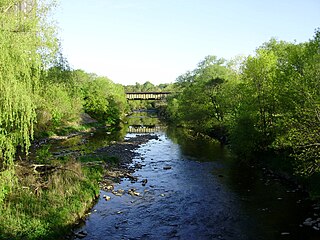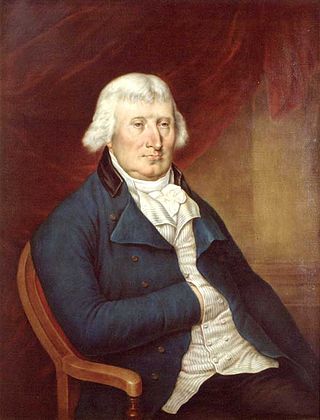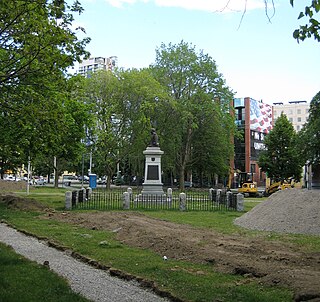
John Graves Simcoe was a British Army general and the first lieutenant governor of Upper Canada from 1791 until 1796 in southern Ontario and the watersheds of Georgian Bay and Lake Superior. He founded York, which is now known as Toronto, and was instrumental in introducing institutions such as courts of law, trial by jury, English common law, and freehold land tenure, and also in the abolition of slavery in Upper Canada.

Yonge Street is a major arterial route in the Canadian province of Ontario connecting the shores of Lake Ontario in Toronto to Lake Simcoe, a gateway to the Upper Great Lakes.

The Humber River is a river in Southern Ontario, Canada. It is in the Great Lakes Basin, is a tributary of Lake Ontario and is one of two major rivers on either side of the city of Toronto, the other being the Don River to the east. It was designated a Canadian Heritage River on September 24, 1999.

John Sandfield Macdonald, was the joint premier of the Province of Canada from 1862 to 1864. He was also the first premier of Ontario from 1867 to 1871, one of the four founding provinces created at Confederation in 1867. He served as both premier and attorney general of Ontario from July 16, 1867, to December 20, 1871.

Etobicoke Creek is a river in the Greater Toronto Area of Ontario, Canada. It is a tributary of Lake Ontario and runs from Caledon to southern Etobicoke, part of the City of Toronto. The creek is within the jurisdiction of the Toronto and Region Conservation Authority.

Peter Russell was an Anglo-Irish military officer in the American War of Independence and a government official, politician and judge in Upper Canada.

Cook's Bay is the southernmost bay of Lake Simcoe in Ontario, Canada. Most of the southern part of the bay is within the jurisdiction of Georgina, a town in the Regional Municipality of York. Its western end is in Simcoe County, and a small portion from the mouth of the Holland River to the Simcoe County border is within Bradford West Gwillimbury. The largest community on the shores of the bay is Keswick.

Dame Elizabeth Posthuma Simcoe was an English artist and diarist in colonial Canada. Her husband, John Graves Simcoe, was the first Lieutenant Governor of Upper Canada. Her diary gives an effective account of Canadian life.

Government House was the official residence of the lieutenant governor of Upper Canada and Ontario, Canada. Four buildings were used for this purpose, none of which exist today, making Ontario one of four provinces not to have an official vice-regal residence.

The Ontario Legislative Building is a structure in central Toronto, Ontario, Canada. It houses the Legislative Assembly of Ontario, and the viceregal suite of the Lieutenant Governor of Ontario and offices for members of the provincial parliament (MPPs). The building is surrounded by Queen's Park, sitting on that part south of Wellesley Street, which is the former site of King's College, which was leased from the university by the municipal government of Toronto in 1859, for a "peppercorn" payment of CAD$1 per annum on a 999-year term. The southern portion of the site was later handed over to the provincial government.

Lord Simcoe Hotel was one of many now vanished hotels in Toronto, Ontario, Canada. Built in 1956, the 20-storey concrete and glass modernist structure was designed by Henry T. Langston and Peter Dickinson. The hotel was named for John Graves Simcoe, Lieutenant Governor of Upper Canada and a resident of York, Upper Canada. The name was somewhat incorrect as Simcoe was never called himself a Lord.

The First Ontario Parliament Buildings were built between 1829 and 1832 near Front, John, Simcoe and Wellington Streets in what was then York, Upper Canada. They served as the parliament buildings for Upper Canada, the Province of Canada, and the province of Ontario after Canadian Confederation in 1867.
German Mills is a community within the city of Markham in Ontario, Canada. The easternmost community in the historic town of Thornhill, German Mills was named for the early German settlers in the area.

Castle Frank Brook is a buried creek and south-west flowing tributary of the Don River in central and north-western Toronto, Ontario, originating near the intersection of Lawrence Avenue and Dufferin Street.

The Queen's Rangers, also known as the Queen's American Rangers, and later Simcoe's Rangers, were a Loyalist military unit of the American Revolutionary War. Formed in 1776, they were named for Queen Charlotte, consort of George III. The Queen's Rangers was a light corps in the tradition of British rangers during the Seven Years' War, operating on the flanks and in advance of Crown forces, manning outposts, conducting patrols, and carrying out reconnaissance and raiding operations.

William Jarvis was a civil servant, militia officer, and the Connecticut-born head of the Jarvis family in what is now Toronto, Ontario, Canada.

Victoria Memorial Square is a park and former cemetery in Toronto, Ontario, Canada. Established in 1793 as the burial place for those affiliated with the nearby Toronto Garrison. It was the first cemetery to be used by European settlers in what would become the city of Toronto. Originally known as St. John's Square, the park today is part of Fort York National Historic Site, and the site of a monument to the War of 1812 sculpted by Walter Seymour Allward and completed in 1902.
Bond Lake (Ontario) is a 55-acre (22 ha) glacial kettle lake in the Oak Ridges Moraine. It is located on the east side of Yonge Street in the north end of Richmond Hill, Ontario.

















